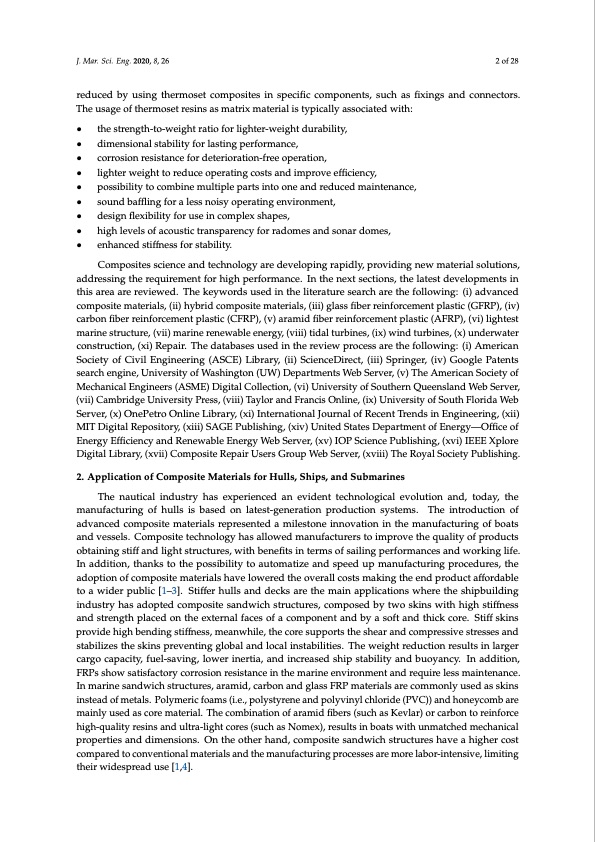
PDF Publication Title:
Text from PDF Page: 002
J. Mar. Sci. Eng. 2020, 8, 26 2 of 28 reduced by using thermoset composites in specific components, such as fixings and connectors. The usage of thermoset resins as matrix material is typically associated with: • the strength-to-weight ratio for lighter-weight durability, • dimensional stability for lasting performance, • corrosion resistance for deterioration-free operation, • lighter weight to reduce operating costs and improve efficiency, • possibility to combine multiple parts into one and reduced maintenance, • sound baffling for a less noisy operating environment, • design flexibility for use in complex shapes, • high levels of acoustic transparency for radomes and sonar domes, • enhanced stiffness for stability. Composites science and technology are developing rapidly, providing new material solutions, addressing the requirement for high performance. In the next sections, the latest developments in this area are reviewed. The keywords used in the literature search are the following: (i) advanced composite materials, (ii) hybrid composite materials, (iii) glass fiber reinforcement plastic (GFRP), (iv) carbon fiber reinforcement plastic (CFRP), (v) aramid fiber reinforcement plastic (AFRP), (vi) lightest marine structure, (vii) marine renewable energy, (viii) tidal turbines, (ix) wind turbines, (x) underwater construction, (xi) Repair. The databases used in the review process are the following: (i) American Society of Civil Engineering (ASCE) Library, (ii) ScienceDirect, (iii) Springer, (iv) Google Patents search engine, University of Washington (UW) Departments Web Server, (v) The American Society of Mechanical Engineers (ASME) Digital Collection, (vi) University of Southern Queensland Web Server, (vii) Cambridge University Press, (viii) Taylor and Francis Online, (ix) University of South Florida Web Server, (x) OnePetro Online Library, (xi) International Journal of Recent Trends in Engineering, (xii) MIT Digital Repository, (xiii) SAGE Publishing, (xiv) United States Department of Energy—Office of Energy Efficiency and Renewable Energy Web Server, (xv) IOP Science Publishing, (xvi) IEEE Xplore Digital Library, (xvii) Composite Repair Users Group Web Server, (xviii) The Royal Society Publishing. 2. Application of Composite Materials for Hulls, Ships, and Submarines The nautical industry has experienced an evident technological evolution and, today, the manufacturing of hulls is based on latest-generation production systems. The introduction of advanced composite materials represented a milestone innovation in the manufacturing of boats and vessels. Composite technology has allowed manufacturers to improve the quality of products obtaining stiff and light structures, with benefits in terms of sailing performances and working life. In addition, thanks to the possibility to automatize and speed up manufacturing procedures, the adoption of composite materials have lowered the overall costs making the end product affordable to a wider public [1–3]. Stiffer hulls and decks are the main applications where the shipbuilding industry has adopted composite sandwich structures, composed by two skins with high stiffness and strength placed on the external faces of a component and by a soft and thick core. Stiff skins provide high bending stiffness, meanwhile, the core supports the shear and compressive stresses and stabilizes the skins preventing global and local instabilities. The weight reduction results in larger cargo capacity, fuel-saving, lower inertia, and increased ship stability and buoyancy. In addition, FRPs show satisfactory corrosion resistance in the marine environment and require less maintenance. In marine sandwich structures, aramid, carbon and glass FRP materials are commonly used as skins instead of metals. Polymeric foams (i.e., polystyrene and polyvinyl chloride (PVC)) and honeycomb are mainly used as core material. The combination of aramid fibers (such as Kevlar) or carbon to reinforce high-quality resins and ultra-light cores (such as Nomex), results in boats with unmatched mechanical properties and dimensions. On the other hand, composite sandwich structures have a higher cost compared to conventional materials and the manufacturing processes are more labor-intensive, limiting their widespread use [1,4].PDF Image | Marine Application of Fiber Reinforced Composites

PDF Search Title:
Marine Application of Fiber Reinforced CompositesOriginal File Name Searched:
jmse-08-00026.pdfDIY PDF Search: Google It | Yahoo | Bing
Development of a solar powered Electric Ship The Electricship website originally started off as a project to develop a comprehensive renewable, affordable, modular electric ship... More Info
Modular Boat Hull Composite The case for a unsinkable, modular composite hybrid boat hull... More Info
MS Burgenstock Hybrid Electric Catamaran Lake Lucerne Unique shuttle servicing Lucerne to the Burgenstock Resort... More Info
Ground Power Unit GPU Powered by Lithium Ion Batteries The goal of the Ground Power Unit is to provide a readily accessible, modular, ready-to-power solution for remote power... More Info
| CONTACT TEL: 608-238-6001 Email: greg@electricship.com | RSS | AMP |